Physics for Everyone: How Global Warming Happens
In the last Physics for Everyone, I discussed just Why Global Warming is Scary. I laid down some pretty simple math using a basic formula of thermodynamics showing us how much energy the atmosphere is gaining due to this warming. What I did not discuss is the whys and hows of the process. Or how we have positively identified man’s influence upon our atmospheric system.
Our weather is a very complicated system. It has an incredible number of variables that are almost too numerous to count – complications in land masses, bodies of water, changes in the Earth’s tilt, and it’s position relative to the sun all have effects on the planet’s mean temperatures, as well as the composition of the atmosphere. Thankfully, statistical analyses as well as detailed observations over time, as well as data gathered in numerous disciplines give us the ability to both come to an understanding of the general behavior of our global weather, and the history of just what’s happened.
Monitoring and measure of temperatures on a global scale began around 1880. Before that, we can go off historical documents ice-core drill samples, tree-ring samples, and sedimentary layer analysis to derive historical global temperature means. Through these analyses climate scientists, paleontologists and geologists have come to a pretty good understanding of what temperature cycles the Earth has experienced in the past. Combining with these findings an analyses of elements found in the sedimentary layers and tree rings, as well as mineral composition, a good deduction of the conditions which caused these temperatures can also be produced.
The resulting analyses show that our planet has undergone quite a few fluctuations in temperature, and those fluctuations seem to fit a fairly good pattern. Within that pattern of oscillating warmth and cold, there is a general down-trend in temperature, which is to be expected as any system over time will tend to cool. This does not disprove global warming as a new trend, but rather reinforces it, as the upwardly climbing temperatures run counter to the general down-trend, as well as to where we should be in the current cycle.

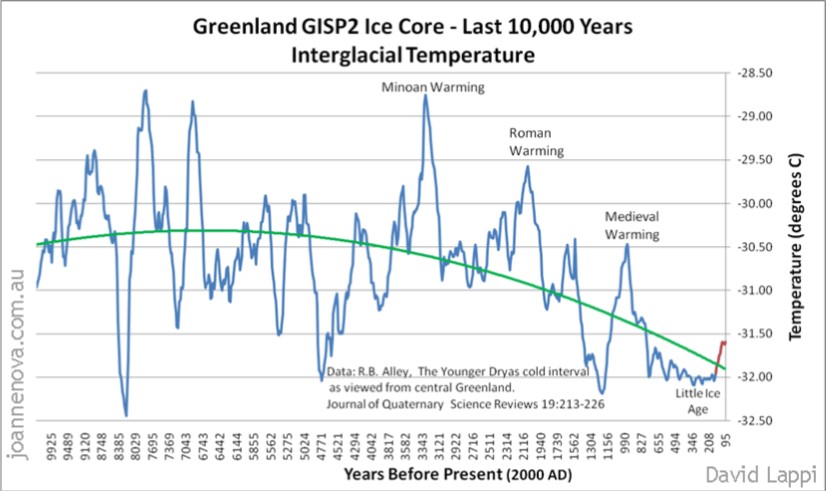
But what causes these cycles? It seems that three key factors are the primary players in the planet’s temperature cycles, with two of those being the prime motivators. Those factors being the sun’s output, the Earth’s orbital position and tilt, and the carbon content of our atmosphere. Let’s examine each in order of influence.
Of the three, intuition would tell us that the sun’s output might have the largest influence upon our climate, and in a way it does, but when we’re talking about CHANGES in climate, it actually does not. Our sun is a fairly stable star, and despite the fact that it does indeed have cycles in the amount of its radiation output, those cycles do not vary enough to overcome the inverse square law – that is, the fact that, as you move further away from a radiating body, the intensity of its radiation upon you decreases as the square of your distance, just due to the fact that the heat is spread out over a larger area. So, say, if you’re receiving 4 units of heat radiation from something at 1 unit of distance, and you then move to 2 units of distance, you’re now receiving only 2 units of heat from that object.
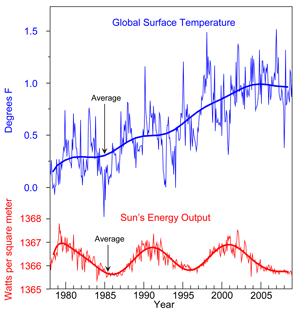
This leads us to the second factor – the earth’s orbital position and tilt. Our planet does not orbit the sun in a perfect circle, but rather in an ellipse, and the foci of this ellipse are not stationary – they move or over time. This means that our distance from the sun changes over time, and does so in cycles (as alterations in celestial bodies’ orbits tend to occur in cyclical fashion). These regular changes in our orbital position were recognized as early as the Celtic druids and the Mayans, who both incorporated longer cycles in their calendars than just the yearly and 4-year cycle we have in our current calendar (the Celts had a 39 year cycle which was an amazing reconciliation between monthly, annual and longer-than annual periods given the technology of the time). Examinations of Greenland and Antarctic ice core samples indicate changes in deuterium levels that account for about a 1000 to 1200 year cycle in climate shift, which we saw in the medieval warm period of around 1000-1200 AD, and the Roman warm period around 200 AD. Within those cycles, we see the effects of the sun’s output change usually in cooler winters in the northern hemisphere as in the 17th Century’s “Mini Ice Age.” Interestingly, we seem to be entering a period of solar quietude similar to that of the 17th Century, which should lead again to cooler winters in the Northern Hemisphere.
However, this leads us to the third and most impactful factor in global temperature changes. Atmospheric carbon content. It is evident from ice core samples, sedimentary layers, as well as distribution of fossils that the carbon content of our atmosphere has actually had a larger influence on climate swings than both changes in our orbital position and solar output together. When we plot historical global temperature change against changes in the atmospheric carbon count, we find a startling correlation.
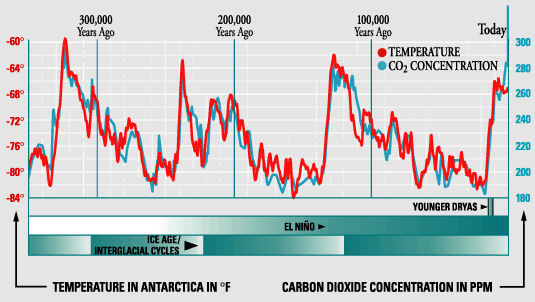
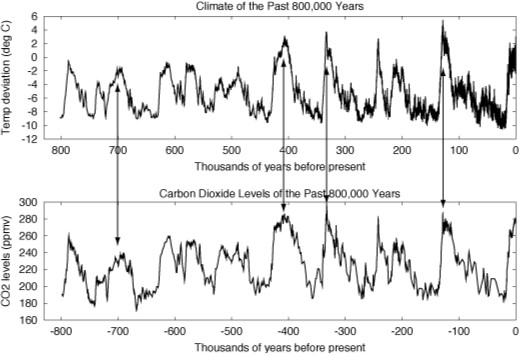
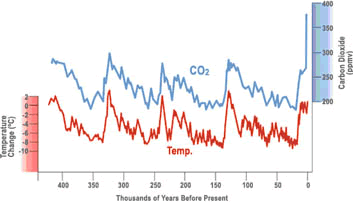
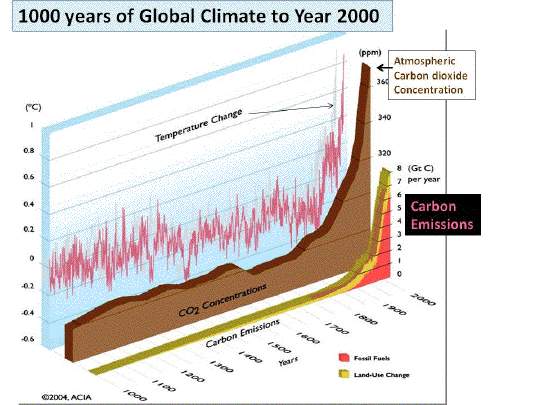
Why does carbon in our air have such an immense effect in the global climate? And what kind of carbon has the biggest influence? Carbon can get in the air in one of two ways: as a solid (usually in the form of ash), or as a gas (usually as carbon dioxide or carbon monoxide, although it can be found in many other gases).
Solid carbon, in ash, can be expelled into the atmosphere in large volumes by forest fires or volcanic eruptions, with volcanic activity putting MUCH more ash in the air than forest fires can. When a large number of eruptions, or big ones, occur, a rapid drop in global temps can follow, as happened after the eruption of Mt. Pinatubo in 1991. This is caused by the solid particles blocking sunlight and preventing its absorption. However, these drops occur quickly, and the global weather as quickly returns to normal as the ash precipitates, or even warmer than before if sufficient amounts of carbon dioxide gas were also released in the eruption.
As a greenhouse gas, increases in carbon dioxide will cause warming of global climate. As a clear gas, it does not block sunlight, and allows it to enter our atmosphere freely. The heat is then reflected, or absorbed and re-radiated by the ground and water. Free of green-house, or heat absorbing, gases, most of that reflected and re-radiated heat would simply escape our planet in straight lines right back into space. However, greenhouse gases absorb some of that heat before themselves re-radiating it in random directions – about half of that going right back DOWN into our planet. The net result of this, is that, as the carbon dioxide count in our atmosphere raises, so too does the amount of heat that fails to escape, and the average global temperatures increase. And this is exactly what we’re seeing right now – huge spikes in carbon gases in our atmosphere accompanied by an anomalous warming of the global climate.
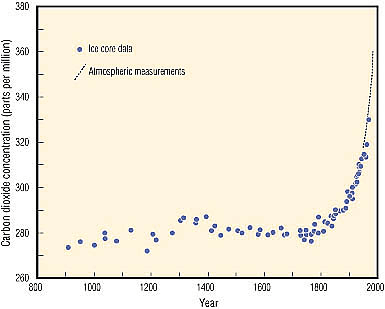
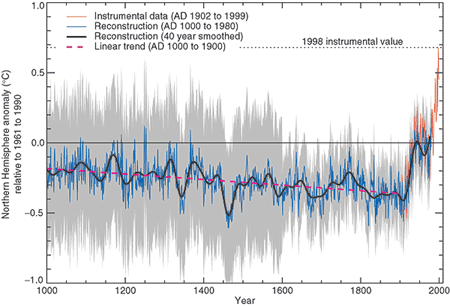
But how do we know that mankind is causing this?
Quite simply, there have not been enough volcanic eruptions, or forest fires, to account for the ENORMOUS increase in carbon dioxide gas we have measured in our air. However, the combined worldwide output of the almost 1 billion cars, and similar number of factories, resulting in 84.2 million barrels of oil and 16 million tons of coal burned PER DAY, more than accounts for the increase in carbon dioxide in the air. And that’s not counting all the other forms of burned fuels we use, or the other manners in which we expel greenhouse gases. Facing these numbers, it is purely idiotic pulling of the wool over our eyes to deny the fact that we are the cause for the sudden dramatic increase in global temperatures we are currently measuring.
We need to change our actions, and change them quickly. This is not one of those cases where we can afford to ease ourselves out of the use of an old technology and into a newer one. Rather, we must quit the burning of fuels for energy and power cold turkey and immediately switch to alternative energy production methods which do not require we burn anything. It is the only way we’ll reverse the process we’ve started that is quite likely to render this planet uninhabitable for our species.
|



